Business Register Quality Improvement in Statistics Finland
Tuula Viitaharju
1. Introduction
The paper deals with the recent project of Statistics Finland. The goal of the project was to revise the direct data collection of the Business Register and the production process following it, to initiate the Register’s systematic quality monitoring and to develop ‘user friendly’ documentation on its processes and variables.
2. Background of the project
The purpose of the Business Register is to uphold a basic statistical register on units practising economic activities, business demographic statistics and a chargeable information service. The Business Register has been maintained since 1968.
Between 1995 and 1998 the technical basis of the Business Register was renewed. During 2001 sub-register of public sector units was merged as part of the revised information system. Estimation methods were reviewed within a separate project and the quality of the Business Register’s location information was improved in a special project.
The technically reformed system was introduced into direct data collection in 1998, but the timing, division and selection of inquiries remained unchanged as did the core areas of the Business Register’s production process. The objectives set by the quality requirements on business statistics entail that the Business Register data should be as real time as possible and the efficiency should be improved at the same time.
The Statistical Office of the European Union, Eurostat recommends in its business register manual systematic monitoring of the quality of the business register data. Eurostat uses a separate form to inquire yearly from national business registers about matters related to the quality of key variables and coverage. Naturally the national users of Business Register need information on BR quality status.
The information system of the Business Register is well documented as to its processing rules and instructions, but for those unfamiliar with the information system its usability may not necessarily have been as good. To advance the use of the Business Register at Statistics Finland, as well as to ensure transfer of knowledge within the Business Register, need has arisen to describe the key processes and variables of the information system.
3. Changes in the Business Register’s production process
3.1 Periodical survey system
In the project the timing, division and selection of Business Register inquiries were revised so that the inquiries were directed to the largest units and to the units with substantial changes in their data. The timing was effected by dividing inquiries into parts and shifting from processing of forms in the spring and autumn to year-round processing, where the largest number of forms are processed between February and May.
Thus the Business Register could function as more high-quality and real-time basic data for the statistics based on it. Processing of inquiries became a year-round task for the Business Register. In processing of inquiries the idea was to keep to the minimum the time it took from filling in a form by an enterprise to its processing in the Business Register. This time shortened from the previous maximum of six months to the present three weeks or so. All information sources on business demographic changes are taken efficiently into account in the selection of inquiries, such as the Trade Register’s and Tax Administration’s merger information, Finland Post Ltd’s business address data, feedback from Statistics Finland’s other departments and changes in monthly wages and salaries data.
The main problem in the situation prior to the project was the time spent from filling the form by the enterprise to its processing in the Business Register. Figure 1 illustrates how the time extended at its highest to six months in 2002. The long delay between the filling and processing discouraged enterprises’ contact persons and increased the respondent burden. The project could cut down this time from the previous six months to the present maximum of about three weeks and thus when asked for additional information about the enterprise on the telephone, the contact persons will remember how they responded and are more motivated to give more information. The general principle is to have the forms processed within around two weeks from their arrival.
3.2 Checking of big structural changes by accelerated schedule
Particular attention was given to the processing of structural change information of enterprises with significant effects on statistics. A special practice was formed for these cases, including utilisation of merger information from the Trade Register of the National Board of Patents and Registration of Finland six times a year, listing of new big enterprises by monthly wage and salary data, media
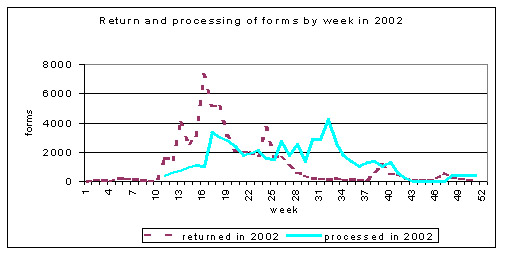
Figure 1. Return and processing of forms in 2002
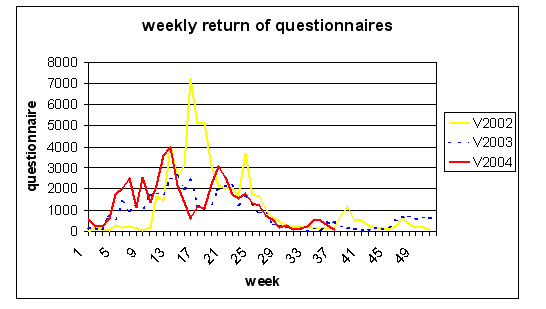
Figure 2. Return of questionnaires 2002 – 2004
monitoring and telephone contacts to starting or merging enterprises. Following this practice, structural changes can be processed around three months after the starting of business or a merger of an enterprise. The target situation, real time, was specified as a business demographic event becoming visible in monthly wage and salary data as two months’ wage and salary payment. This accelerated processing of big structural changes by one year or even one and a half years, depending on the case.
3.3 The Business Register’s production process as a whole
In connection with the revision of data collection, the production process of the Business Register was considered as a whole. The timing of checking of data and dividing enterprise-level data up to local kind of activity units was advanced and thus work previously focusing on the end of the year could now be divided into all year round tasks. The checking programs were examined during the project and their implementation was re-allocated. After re-allocation the number of logical errors in the production database could be lowered by working continuously on error situations. Some of the checking procedures could now be started and timed from the online application.
As a result of the revision of direct data collection and the rest of the production process, the schedule of the annual data for 2002 from the Business Register was speeded up by five weeks and accordingly the schedule of the data for 2003 is seven weeks faster that for 2001.
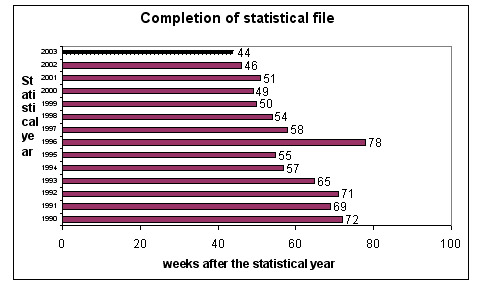
Figure 3. Completion schedule of the Business Register’s statistical file
3.4 Influence on the organisation of duties in BR department
The reforms and reallocation of workload enabled transferring of many tasks to the experts in the topic area and setting up of a functioning deputy system. These measures helped to accelerate the schedule of the entire production. In the operation of the Business Register the focus was shifted from producing annual statistics towards maintaining an optimally real-time register.
4. Measurement of quality
Two new quality indicators for the Business Register were developed – coverage measurement and the quality control survey. These will be used in future to monitor regularly the quality level of the Business Register.
The tools used in quality measurement were the coverage in relation to administrative records and the measurement of the quality of the key variables of enterprises outside annual Business Register inquiries by means of a quality control survey.
4.1 Coverage measurement
Regulation on business registers and the Business Register’s present coverage
According to the regulation on business registers (Council Regulation (EEC) No. 2186/1993), all enterprises carrying on economic activities contributing to the gross domestic product at market prices (GDP) should be gathered in a business register.
The Finnish Business Register covers the following units:
– Regular employers,
– Those liable to value added tax,
– Those entered in the prepayment register.
The Business Register covers enterprises outside agriculture and forestry. The Tax Administration’s customer database is the Business Register’s main source for maintaining basic information on legal units.
Key results from the coverage measurement of the Business Register’s coverage
The coverage reporting of the Business Register in 2002 searched for all the units in the Tax Administration’s business taxation data (VEROTK), monthly payment control data (MAVA) and annual wage and salary data (pay as you earn, VILMTK) that were missing from the Business Register in the statistical year 2002. The numbers of the missing units by source:
VILMTK units (P.A.Y.E) 30,957
VEROTK units (business tax) 10,614
MAVA units (monthly payment control) 6,465
When the unpaired business IDs were matched to one another, that is, overlapping between the data was eliminated, this resulted in a total of 44,417 units that were absent from the Business Register in the statistical year 2002. The table below lists the four largest groups examined by legal form that were missing from the Business Register. In the statistical year 2002, a total of 3,235 limited companies with a turnover of around EUR 637 million were absent from the Business Register. Relative to the Business Register’s statistical file for 2002, the turnover proportion of unpaired VEROTK units was 0.6 per cent and the wage bill proportion of unpaired VILMTK units was 0.3 per cent.
The coverage analysis indicates that the coverage of the Business Register is good. The matter will be followed with this procedure yearly.
|
Legal form |
Statistical year 2002 |
|
Number of units |
Turnover, MEUR |
Wage bill, MEUR |
|
Limited companies |
3,235 |
637,1 |
5,6 |
|
Housing and real estate corporations |
23,507 |
766,5 |
22,5 |
|
Foundations and funds |
6,326 |
3,4 |
31,5 |
|
Natural persons |
3,614 |
31,2 |
9,2 |
|
Total |
44,417 |
1,603,6 |
101,7 |
|
% of BR total |
13,7 |
0,6 |
0,3 |
Table 1. Units missing from the Business Register, breakdown by legal form
4.2 Quality control survey
An annually conducted quality control survey was planned and implemented in the project. The quality control survey is used to examine the correctness of industry and location information for small single-local kind of activity unit enterprises. The target group was limited so that
– The units fulfil the selection conditions for the Business Register’s statistical file,
– The units do not belong to the scope of the normal annual survey of the Business Register (which are multi-local kind of activity unit and large single-local kind of activity unit enterprises).
The sampling method used was stratified sampling by relative allocation so that at least 50 units were selected from each stratum. The stratum used was Section level (1-letter) industry. The sample frame of the quality control survey included 202,941 enterprises, of which 957 were selected for the survey. A total of 803 enterprises responded to the inquiry, which brings the response rate to 83.9 per cent.
On the basis of the results of the quality control survey it can be estimated that among units outside the ordinary annual surveys of the Business Register (small single-local kind of activity unit enterprises), the Section-level NACE code is correct for 95 per cent and the 5-digit level NACE is correct for 90 per cent of the enterprises. The location data indicates some lower levels of quality.
Location address (street address) is correct for 71 per cent and the postal code of the location address for 88 per cent of the enterprises. The municipality of location was correct for 94 per cent of all enterprises. Only one per cent of the responding enterprises had new local kind of activity units absent from the Business Register. The matter will be monitored yearly with this procedure.
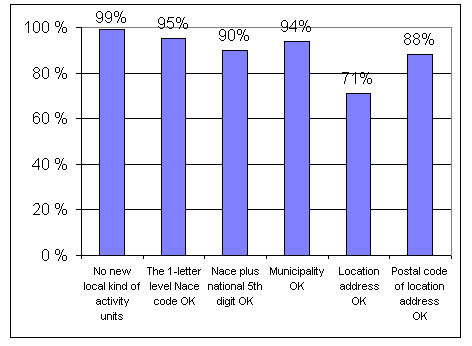
Figure 4. Proportion of error-free information in the Business Register
5. Descriptions of variables and processes
Business Register Recommendations Manual raises Clarity and Accessibility as one of the quality criteria of BR. The key processes of the Business Register and the formation of Business Register variables were described. The purpose of these descriptions was to serve as documentation of BR and ease the interpretation of register information.. They will in future facilitate the operation within the Business Register section and the use of the Business Register at Statistics Finland.
5.1 Variable descriptions of the Business Register
Descriptions were made of the substantial group of variables in the entity relationship model of the BR databases. Production database, service database as well as annual statistical file was described. In all, about 730 variables were described in the project. Appendix 1 lists the tables from which variable descriptions were made and it also gives one example of description.
Production database tables include legal unit and corresponding annual data, local kind of activity unit and corresponding annual data, monthly data on legal unit and all enterprise group tables (a total of about 370 variables out of around 950 available variables). In addition, descriptions were given of the variables of legal unit and local kind of activity unit tables in the service database and the corresponding annual data tables (in all, about 250 variables) and of the legal unit and local kind of activity unit variables of the statistical file (altogether around 110 variables).
As a rule, the description indicates the content, source and processing rules of the variable. It can also contain information about the classifications, processing practices and instructions. The name of the variable and what it means is given under ’content’. The possible values of code-type variables and their explanations are listed. The target and purpose of use of the variable can also be mentioned. Under ’source’ it is indicated from where or how the value of the variable is derived. Sources are such as administrative and other external sources, inquiries and programmatic determination. The number and name are given of the processing rules.
The descriptions are compiled into a Word document containing a total of 151 text pages and a table of contents.
5.2 Process descriptions of the Business Register
Process descriptions were prepared for around 30 key processes of the Business Register. The Business Register’s key processes (see Appendix) were divided into three groups: inputs, processing and outputs (according to: Overview of the Business Register production system). The ‘inputs’ group contained processes related to updating of the data, such as updating of administrative or processing of Business Register surveys. The ‘processing’ group consisted of various processes related to the Business Register’s production database, such as processing of general government and enterprise groups, change of statistical year and maintenance of the Business Register ID system. The ‘outputs’ group comprised compilation processes of end products made from the Business Register’s production database, such as updating of the service database and creation and checking of the statistical file.
The process was described with a flow process chart (one page) and the related text (one page), that is, each process description is two pages long. The textual description was made as clearly as possible and all the terms and abbreviations were explained. The principle was that the process description should be unambiguous and understandable - user friendly.
The existing material on the Business Register’s processes and systems was utilised as far as possible in the compilation of process descriptions, such as processing rules, instructions and IT system descriptions.
The compiled process descriptions illustrate the present state of the process. A general description was made of each process but more detailed descriptions of sub-processes were prepared for some processes.
The process descriptions were made with the PowerPoint program that could be used for both charts and texts. Because the PowerPoint does not require any separate user licences, the process descriptions can be easily distributed to a larger customer group and the maintenance of the descriptions can be assigned to several persons.
5.3 Utilisation of variable and process descriptions
The variable and process descriptions of the Business Register form a sort of manual together with the entity relationship model of the production database. It can be utilised for example for internal training and job orientation at the Business Register section and for its introduction and training events arranged for employees in other departments of Statistics Finland. The manual is available to all at Statistics Finland Intranet. It will be kept up-to-date and it can be supplemented if necessary.
6. Conclusions
The major achievement of the project can be considered to be that the Business Register’s production process adjusted well to the personnel resources and the production speeded up and the updating of enterprises’ structural changes could be made into as real time as practically possible.
The revision of inquires has been seen as very positive. Dividing the processing of inquiries to a longer time period means that smaller batches of forms can be processed at a time than before, and they can be mostly processed before the arrival of the next batch. This produces the positive feeling that something is being completed. The revision allowed the forms to be processed with the delay of at most one month from the time when they were filled in. This helps both data suppliers and inquirers. If additional information needs to be requested over the telephone, it is easier to talk about the forms filled in a few weeks than six months ago.
Transformation of some checking programs into online applications allowed them to be performed by production employees. This has diversified job contents and rendered the work more meaning ful. As a result, a system of deputies was also set up.
Faster clarification of structural and business demographic information benefits customers using register data. It has also made it possible to advance the timing of checkings and accelerate production. In all, the maintenance of an optimally real-time register has become the focal point for the production of the Business Register, from which statistics can also be produced faster.
The quality control survey and the coverage analysis were found to be good and sound measurements for quality. The results of the coverage analysis indicated that the coverage of the Business Register is good. An advantage of the quality control survey is that it is possible to utilise existing inquiries and it does not thus require much extra work and can be carried out easily. Both the coverage reporting and the quality control survey are meant to be conducted in future every year.
Together with the entity relationship model of the production database the variable and process descriptions form a sort of a Business Register manual, a Handbook, that can be utilised by Business Register employees and other users of BR data. The descriptions are planned to be kept up-to-date and update them whenever there are any changes in the system. They are stored in Statistics Finland’s intranet and they are available to everyone working at Statistics Finland.
Appendix 1 Variable descriptions of the Business Register
The variable descriptions were made of the variables of the following tables:
PRODUCTION DATABASE
Legal unit
Annual information on legal unit
Monthly information on legal unit
Local kind of activity unit
Annual information on local kind of activity unit
Enterprise group
Annual information on enterprise group
Relation between enterprise group and enterprise
History information on relation between enterprise group and enterprise
Relation between two enterprise groups
Relation between enterprise group and unpaired enterprise
Foreign enterprise
Relation between enterprise group and foreign enterprise
SERVICE DATABASE
Information on legal unit in the service database
Annual information on legal unit in the service database
Information on legal local kind of activity unit in the service database
Annual information on legal local kind of activity unit in the service database
STATISTICAL FILE
Statistical file on enterprises
Statistical file on local kind of activity units
Example of variable description
structure of the description is as follows:
Title: oyr_omist_tyyppi
Content: Owner type of legal unit. Owner types are:
1= Private domestic
2= State
3= Municipality
4= Region of Åland
5= Foreign-owned
6= Other owner type
Source: Tax Administration’s customer database (ASITK), Bank of Finland, Register of Enterprise Groups
Processing: Inferred by default from the code of legal form. In type 5 foreign ownership is at least 50 per cent. This is used only for corporate units. For legal units which are subsidiaries of enterprise groups, ownership information is updated according to the parent of the group.
Processing rule: A31.1 Processing rule for updating of the Tax Administration’s customer database, B62.4 Inference of owner type by means of enterprise group information, A34 Updating with the Bank of Finland data.
Appendix 2 Process descriptions of the Business Register
Overview of the Business Register’s production system
INPUT processes
– Updating of the Tax Administration’s customer database
– Updating of Invest Byro in Finland data
– Updating of street database
– Updating of standard respondent data
– Updating of map co-ordinate information
– Updating of the Tax Administration’s payment control data
– Updating of Finland Post’s business address data
– Merger information of the National Board of Patents and Registration of Finland
– Updating of the Bank of Finland data
– Data transfer process between the Business Structures unit’s structural data and the Business Register
– Updating of the National Board of Customs data
– Updating of the Tax Administration’s business taxation data
– Updating of the Tax Administration’s annual wage and salary data
– State-owned enterprises
– Progress and processing of Business Register inquiries
PROCESSING
– Estimation and division of personnel (employees and self-employed persons)
– Special process of public sector units
– Enterprise groups
– Local government ownership
– Change of statistical year
– Determination and checking of the location municipality of the local kind of activity unit
– Processing of intra-enterprise demographic information on the basis of the information received from the Tax Administration
– Formation of annual level classification data
– Identification code system of the Business Register
OUTPUT processes
- Updating of the service database
- Compilation of statistics on enterprise start-ups and closures
- Creation and checking of the statistical file
- Checking of the Business Register’s production database before creation of the statistical file
- Compilation of the annual publication
- Updating of StatFin
- Preparation of the Business Register Service Guide
Appendix 3 Process descriptions of the Business Register: An example
Production system of the Business Register (BR)
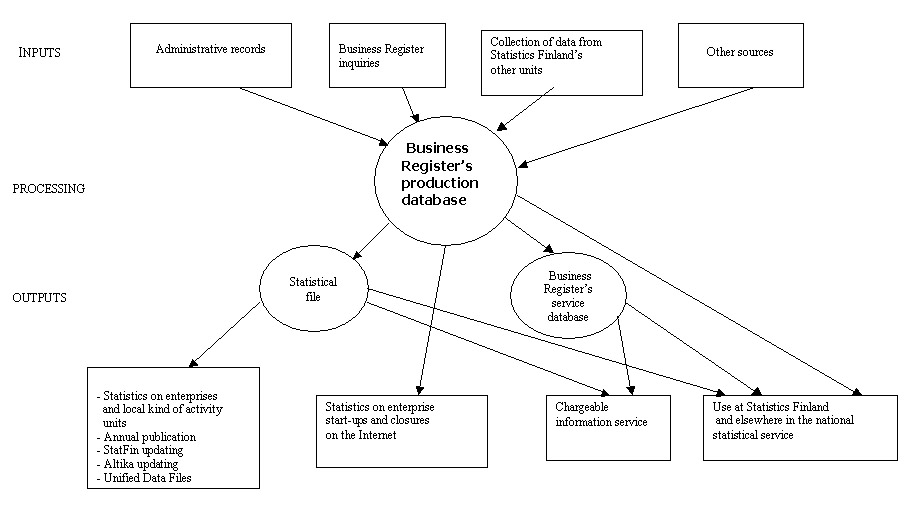
Production system of the Business Register (BR)
INPUTS
Data from administrative records are collected from the Tax Administration’s registers (customer database, business taxation data, payment control data and annual wage and salary data), and from administrative data records of the National Board of Patents and Registration of Finland, the National Board of Customs, the State Treasury, the Bank of Finland and the Local Government Pensions Institution.
The Business Register’s own inquiries are used to collect data on all multi-local kind of activity units enterprises with at least ten employees and on large single-local kind of activity unit enterprises. On small enterprises the units are inquired when the Business Register have got information for instance from Statistics Finland’s other units or Finland Post’s business address data that location or industry of the enterprise have changed. Newly established enterprises are usually contained once in the inquiry on new enterprises quite soon after starting operations.
Collection of data from Statistics Finland’s other units includes such as the Business Structures unit’s structural data.
Other sources are such as the business address data and basic address data from Finland Post Ltd (includes data on municipality, postal code, street address, street number) and map co-ordinate data from the Population Register Centre.
PROCESSING
Processing of inputs takes place in the Business Register’s production database, where the units of the Business Register (single and multi-local kind of activity units enterprises, general government, their local kind of activity units and enterprise groups) and data on them are maintained. The service database and the statistical file of the Business Register are prepared on the basis of the Business Register’s production database.
OUTPUTS
The statistical file is compiled yearly from the data of the statistical year in question. The statistical file covers all enterprises and their local kind of activity units outside agriculture and forestry. Only farms acting as employers are included from agriculture and forestry. Enterprises whose operation has ended during the first half of the year or that have had only little operation during the year are excluded from the statistical file. The data of the statistical file are used to compile statistics on enterprises and local kind of activity units, the annual publication, StatFin updating, Altika updating, the Unified Data Files and chargeable products.
The Business Register’s service database is a service database formed of the units of the Business Register containing data meant for customer use on enterprises, government agencies, municipalities, joint municipal boards and their local kind of activity units. The service database is updated monthly.
The statistics on enterprise start-ups and closures on the Internet contain data on the number of enterprise start-ups and closures by industry, area and legal form. The statistics are produced quarterly.
|